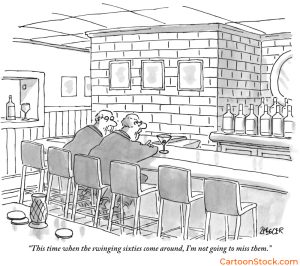
Cartoon critics Phil Witte and Rex Hesner look behind the gags to debate what makes a cartoon tick. This week our intrepid critics take a look at History.
When viewed by our cartoonists, the scope and sweep of human history provide an unlimited canvas for invention. Significant events can be rearranged, reimagined, or just plain made up.
Sadly, little remains of our prehistoric past for reconstructing their lives. That didn’t deter our first cartoonist, Bob Mankoff, from putting words into the mouths of our ancient ancestors. Who knew a caveman would quote political philosopher Thomas Hobbes when lamenting the quality-of-life millennia ago?
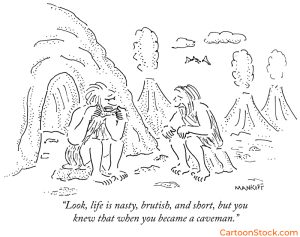
The ground-breaking tragedies in ancient Greece set the mold for our modern theater. Performed to this day, these stories were rooted in local mythology and religion. But, according to Bruce Kaplan, some performances varied in tragic consequences. And he should know–Kaplan’s a successful TV writer, producer, and show-runner.
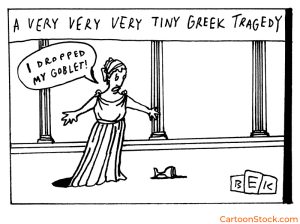
The origins of Britain’s Stonehenge are lost in the mists of time. Why and how it was built remains irretrievable to even the most dedicated archeologists. Fortunately, cartoonist Gahan Wilson, whose use of perspective creates a mystical feel, has a logical conjecture as to why further construction was halted. Does anyone have a better theory?
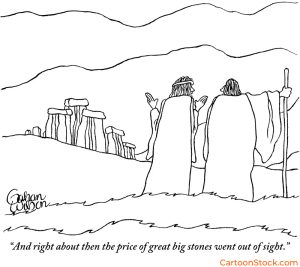
It’s challenging to imagine Egypt’s rich and cultured civilization 5,000 years ago. All that remains are the gigantic pyramids and statues built at a stupendous cost to the population. Our time-traveling cartoonist, Frank Cotham, imagines what a grateful nation would say if things had been handled differently. It’s worth noting how Cotham’s use of white space in the center of the drawing illustrates his caption.
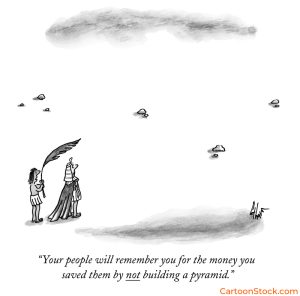
Trevor Spaulding’s roaring fire beside sumptuous mullioned windows makes for a romantic birthday setting. But the lady seems off-put by her Elizabethan swain, a dead ringer for Will Shakespeare. We suppose the novelty of receiving a heartfelt sonnet, one of 154 penned in the Bard’s lifetime, might wear off over time. But did the gift of an immortal poem warrant this level of sarcasm?
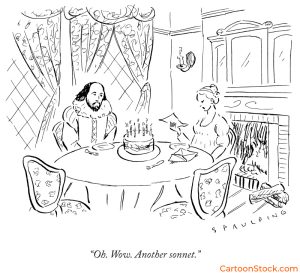
One of the timeless scenarios in the cartoon world is two people unburdening themselves in a bar. So, not only are these religious adherents getting sloshed midday, but the speaker is confessing to a nefarious scheme. Cartoonist Zachary Kanin knows his history well enough to dress these Salem Village imbibers in Puritan garb, right down to the hat buckles and linen ruffs.
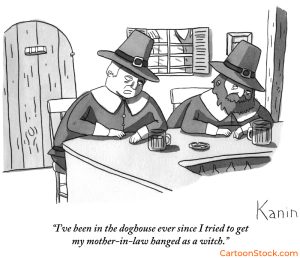
David Borchart, one of our favorite illustrators, re-creates the splendor of Versailles in its heyday. In front of mansard roofs and gushing fountains, two decked-out courtiers discuss life during the glorious age of the Sun King, Louis XIV. Hmm, or maybe not so glorious …
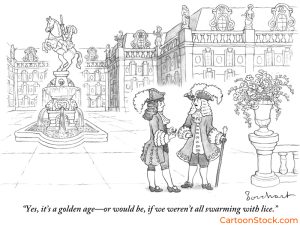
J. B. Handelsman eavesdrops on an editorial session with Charles Dickens for his masterpiece, A Tale of Two Cities. Dickens, nervously worrying his beard, looks a bit glum at what he’s hearing. Handelsman nails the period with the high collar and muttonchop sideburns worn by the editor. The stack of manuscript paper is a nice touch.
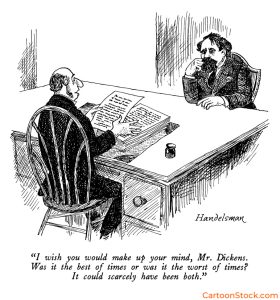
Westerns are a unique American offering, whether on TV or in the theater. Many a cowboy conflict started at the poker table with underhanded play. If caught, you were lucky to be run out of town or roughly tossed into the street. Zachary Kanin uses the old anachronism approach to create the gag, and imagines a West more mild than wild.
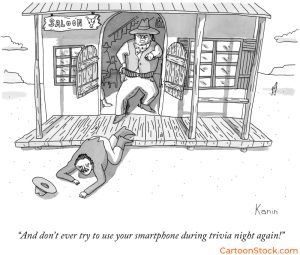
Our final cartoon belongs to none other than cartoon titan Jack Ziegler. Published in The New Yorker in 2011, two balding oldsters reminisce about an era that passed them by. The gents sit shoulder-to-shoulder in the empty bar, with at least one martini onboard. Yet, despite the note of melancholy in the humor, Ziegler still summons an innate sense of American optimism from the speaker, no matter how unrealistic.
